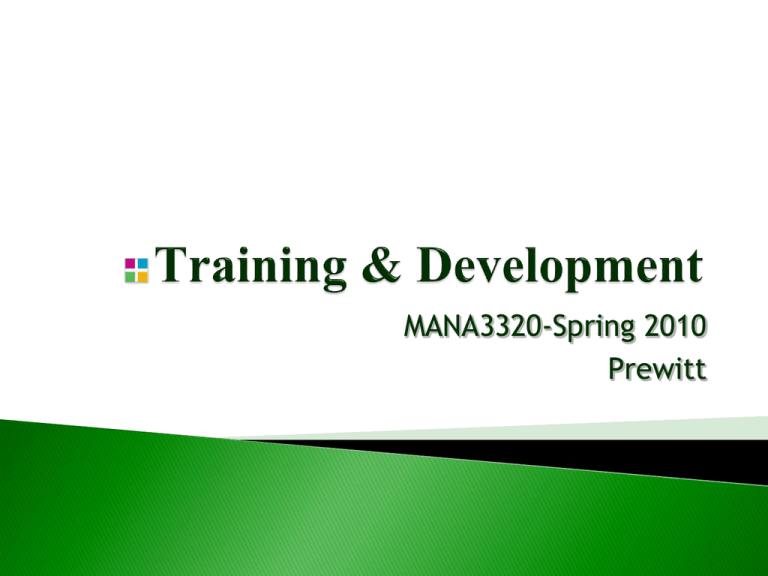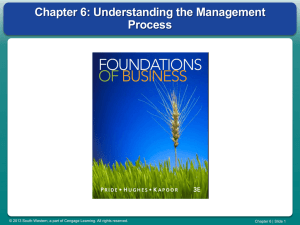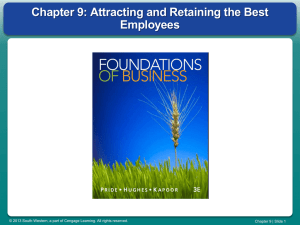
MANA3320-Spring 2010
Prewitt
Training and Development and
Other HRM Functions
Availability of training can aid
in recruitment
Recruitment
Provide an additional
source of trainees
Training may permit hiring
less-qualified applicants
Selection
Effective selection may
reduce training needs
Training aids in the
achievement of performance
Performance
Appraisal
A basis for assessing
training needs and results
Training and development may
lead to higher pay
Compensation
Management
A basis for determining
employee’s rate of pay
Training may include
a role for the union
Labor Relations
Union cooperation can
facilitate training efforts
© 2010 South-Western, a part of Cengage Learning. All rights reserved.
7–2
The Scope of Training
• Training
Effort initiated by an organization to foster learning
among its members.
Tends to be narrowly focused and oriented toward
short-term performance concerns.
• Development
Effort that is oriented more toward broadening an
individual’s skills for the future responsibilities.
© 2010 South-Western, a part of Cengage Learning. All rights reserved.
7–3
FIGURE
7.1
Training Dollars Spent by Employee Type
© 2010 South-Western, a part of Cengage Learning. All rights reserved.
7–4
The Systems Approach to Training and
Development
• Four Phases
Needs assessment
Program design
Implementation
Evaluation
© 2010 South-Western, a part of Cengage Learning. All rights reserved.
7–5
FIGURE
7.2
Systems Model of Training
© 2010 South-Western, a part of Cengage Learning. All rights reserved.
7–6
Phase 1: Conducting the Needs Assessment
• Organization Analysis
An examination of the environment, strategies, and
resources of the organization to determine where
training emphasis should be placed.
• Task Analysis
The process of determining what the content of a
training program should be on the basis of a study
of the tasks and duties involved in the job.
• Person Analysis
A determination of the specific individuals who
need training.
© 2010 South-Western, a part of Cengage Learning. All rights reserved.
7–7
FIGURE
7.3
Needs Assessment for Training
Competency assessment
Analysis of the sets of skills and knowledge needed
for decision-oriented and knowledge-intensive jobs
© 2010 South-Western, a part of Cengage Learning. All rights reserved.
7–8
1
Notes on Rapid Needs Assessment
NOTE 1: Look at the problem scope
NOTE 2: Do organizational scanning
NOTE 3: Play “give and take”
NOTE 4: Check “lost and found”
NOTE 5: Use plain talk
NOTE 6: Use the Web
NOTE 7: Use rapid prototyping
NOTE 8: Seek out exemplars
© 2010 South-Western, a part of Cengage Learning. All rights reserved.
7–9
2
A Competency Assessment for a Managerial Position
For each item, circle the number that best describes the manager’s characteristics. For items
that do not apply, circle NA (not applicable). For other items for which you lack sufficient
observations or documentary evidence, circle DK (don’t know).
4=Exemplary, 3=Proficient, 2=Progressing, 1=Needs Assistance, NA=Not Applicable, DK=Don’t Know
Competency 1: Behaves professionally and encourages other staff members to do likewise.
4 3 2 1 NA DK
Competency 2: Behaves ethically and encourages staff members to do likewise.
4 3 2 1 NA DK
Competency 3: Uses a variety of modes of communication and conveys information fully
and clearly.
4 3 2 1 NA DK
Competency 4: Seeks input from all levels and demonstrates fairness and consistency.
4 3 2 1 NA DK
Competency 5: Engages in an open style of management and is open to criticism from
supervisors and subordinates.
4 3 2 1 NA DK
Competency 6: Searches for and embraces innovative solutions to improve department’s
programs and products.
4 3 2 1 NA DK
© 2010 South-Western, a part of Cengage Learning. All rights reserved.
7–10
Phase 2: Designing the Training Program
Issues in training design
Instructional objectives
Trainee readiness and motivation
Principles of learning
Characteristics of successful trainers
© 2010 South-Western, a part of Cengage Learning. All rights reserved.
7–11
Phase 2: Designing the Training Program
• Instructional Objectives
Represent the desired outcomes of a training
program
Performance-centered objectives
Provide a basis for choosing methods
and materials and for selecting
the means for assessing
whether the instruction
will be successful.
© 2010 South-Western, a part of Cengage Learning. All rights reserved.
7–12
Trainee Readiness and Motivation
• Strategies for Creating a Motivated Training
Environment:
1. Use positive reinforcement.
2. Eliminate threats and punishment.
3. Be flexible.
4. Have participants set personal goals.
5. Design interesting instruction.
6. Break down physical and psychological obstacles to
learning.
© 2010 South-Western, a part of Cengage Learning. All rights reserved.
7–13
FIGURE
7.4
Principles of Learning
© 2010 South-Western, a part of Cengage Learning. All rights reserved.
7–14
Principles of Learning
Focus on learning and transfer
Goal setting - What’s the value?
Meaningfulness of presentation
Behavioral modeling
Recognition of individual learning
differences
© 2010 South-Western, a part of Cengage Learning. All rights reserved.
7–15
Principles of Learning (cont’d)
Focus on method and process
Active practice and repetition
Whole versus-part learning
Massed-vs-distributed learning
Feedback and reinforcement
© 2010 South-Western, a part of Cengage Learning. All rights reserved.
7–16
Feedback and Reinforcement
• Spot Rewards
Programs that award employees
“on the spot” when they do
something particularly well
during training or on the job
• Behavior Modification
The technique that operates on the principle that
behavior that is rewarded, or positively reinforced,
is repeated more frequently, whereas behavior that
is penalized or unrewarded will decrease in
frequency.
© 2010 South-Western, a part of Cengage Learning. All rights reserved.
7–17
FIGURE
7.5
A Typical Learning Curve
© 2010 South-Western, a part of Cengage Learning. All rights reserved.
7–18
Characteristics of Successful Instructors
• Knowledge of the subject
• Adaptability
• Sincerity
• Sense of humor
• Interest
• Clear instructions
• Individual assistance
• Enthusiasm
© 2010 South-Western, a part of Cengage Learning. All rights reserved.
7–19
Phase 3: Implementing the Training Program
Choosing the instructional method
Nature of training
Type of trainees
Organizational extent of training
Importance of training outcomes
© 2010 South-Western, a part of Cengage Learning. All rights reserved.
7–20
Training Methods for
Nonmanagerial Employees
• On-the-Job Training (OJT)
• Apprenticeship Training
• Cooperative Training,
Internships, and
Governmental Training
• Classroom Instruction
• Programmed Instruction
• Audiovisual Methods
• Computer-based Training
and E-Learning
• Simulation Method
© 2010 South-Western, a part of Cengage Learning. All rights reserved.
7–21
Training Methods for Nonmanagerial
Employees (cont’d)
• On-the-job training (OJT)
Method by which employees are given hands-on
experience with instructions from their supervisor
or other trainer.
• Drawbacks
The lack of a well-structured training environment
Poor training skills of managers
The absence of well-defined job performance
criteria
© 2010 South-Western, a part of Cengage Learning. All rights reserved.
7–22
On-the-Job Training
• Overcoming OJT training problems
1. Develop realistic goals and/or measures for each
OJT area.
2. Plan a specific training schedule for each trainee,
including set periods for evaluation and feedback.
3. Help managers establish a nonthreatening
atmosphere conducive to learning.
4. Conduct periodic evaluations, after training is
completed, to prevent regression.
© 2010 South-Western, a part of Cengage Learning. All rights reserved.
7–23
FIGURE
7.6
The PROPER Way to Do On-the-Job Training
© 2010 South-Western, a part of Cengage Learning. All rights reserved.
7–24
Training Methods for Nonmanagerial
Employees (cont’d)
• Apprenticeship training
A system of training in which a worker entering the
skilled trades is given thorough instruction and
experience, both on and off the job, in the practical
and theoretical aspects of the work.
• Cooperative Training
A training program that combines practical on-the-
job experience with formal educational classes.
© 2010 South-Western, a part of Cengage Learning. All rights reserved.
7–25
Training Methods for Nonmanagerial
Employees (cont’d)
• Internship Programs
Are jointly sponsored by colleges, universities, and
other organizations that offer students the
opportunity to gain real-life experience while
allowing them to find out how they will perform in
work organizations.
• Classroom Instruction
Enables the maximum number of trainees to be
handled by the minimum number of instructors.
“Blended” learning—lectures and demonstrations are
combined with films, DVDs, and videotapes or computer
instruction.
© 2010 South-Western, a part of Cengage Learning. All rights reserved.
7–26
Increasing the Effectiveness of Internships
1. Assign the intern to projects that are accomplishable
and provide training as required.
2. Appoint a mentor or supervisor to guide the intern.
3. Solicit project suggestions from other staff members.
4. Rotate interns throughout the organization.
5. Treat interns as part of the organizational staff and
invite them to staff meetings.
6. Establish a process for considering interns for
permanent hire.
© 2010 South-Western, a part of Cengage Learning. All rights reserved.
7–27
FIGURE
7.7
Delivery Method of Training
© 2010 South-Western, a part of Cengage Learning. All rights reserved.
7–28
Training Methods for Nonmanagerial
Employees (cont’d)
• Programmed Instruction
Self-directed learning—use of books, manuals, or
computers to break down subject matter content
into highly organized, logical sequences that
demand continuous response on the part of the
trainee.
• Audiovisual Methods
Video recordings, CDs and DVDs
Teleconferencing and videoconferencing
Web conferencing, webinars, and podcasts
Communities of practice, blogs, and wikis
© 2010 South-Western, a part of Cengage Learning. All rights reserved.
7–29
FIGURE
7.8
Examples of Knowledge-Sharing Learning
via Communities of Practice
Problem-solving
“Can we work on this design and brainstorm some ideas; I’m stuck.”
Requests for information
“Where can I find the code to connect to the server?”
Seeking experience
“Has anyone dealt with a customer in this situation?”
Reusing assets
“I have a proposal for a local area network I wrote for a client last year. I
can send it to you, and you can easily tweak it for this new client.”
Coordination and synergy
“Can we combine our purchases of solvent to achieve bulk discounts?”
Discussing developments
“What do you think of the new CAD system? Does it really help?”
Documentation projects
“We have faced this problem five times now. let us write it down once
and for all.”
Visits
“Can we come and see your after-school program? We need to
establish one in our city.”
Mapping knowledge and
identifying gaps
“Who knows what, and what are we missing? What other groups should
we connect with?”
© 2010 South-Western, a part of Cengage Learning. All rights reserved.
7–30
Training Methods for Nonmanagerial
Employees (cont’d)
• Simulation
The simulation method emphasizes realism in
equipment and its operation at minimum cost and
maximum safety.
Used when it is either impractical or unwise to train
employees on the actual equipment used on the job.
© 2010 South-Western, a part of Cengage Learning. All rights reserved.
7–31
Training Methods for Employees (cont’d)
• E-Learning
Learning that takes place via such web and
computer-based training (CBT)
Allows the firm to bring the training to employees
Allows employees to customize their own learning in
their own time and space (just-in-time learning)
Provides continuously updated
training materials
© 2010 South-Western, a part of Cengage Learning. All rights reserved.
7–32
Electronic Training Methods for Employees
• Learning Management Systems (LMS)
are “virtual learning environments”
Can assess the skills of employees
Can register them for courses
Can deliver interactive learning modules directly to
their desktops when they need or want them
Can evaluate and track their progress, and
determine when they are ready to be promoted
© 2010 South-Western, a part of Cengage Learning. All rights reserved.
7–33
Training Methods for Management
Development
• On-the-Job Experiences
• Seminars and Conferences
• Case Studies
• Management Games
• Role Playing
• Behavior Modeling
© 2010 South-Western, a part of Cengage Learning. All rights reserved.
7–34
On-the-Job Experiences
• Coaching
• Understudy Assignment
• Job Rotation
• Lateral Transfer
• Special Projects
• Action Learning
• Staff Meetings
• Planned Career
Progressions
© 2010 South-Western, a part of Cengage Learning. All rights reserved.
7–35
Case Studies
• The use of case studies is most appropriate
when:
1. Analytic, problem-solving, and critical thinking
2.
3.
4.
5.
skills are most important.
The KSAs are complex and participants need time
to master them.
Active participation is desired.
The process of learning (questioning,
interpreting, and so on) is as important as the
content.
Team problem solving and interaction are
possible.
© 2010 South-Western, a part of Cengage Learning. All rights reserved.
7–36
FIGURE
7.9
Case Studies
When Using Case Studies…
• Be clear about learning objectives, and list possible ways to achieve the
objectives.
• Decide which objectives would be best served by the case method.
• Identify available cases that might work, or consider writing your own.
• Set up the activity—including the case material, the room, and the schedule.
• Follow the principles of effective group dynamics.
• Provide a chance for all learners to take part and try to keep the groups small.
• Stop for process checks and be ready to intervene if group dynamics get out
of hand.
• Allow for different learning styles.
• Clarify the trainer’s role.
• Bridge the gap between theory and practice.
© 2010 South-Western, a part of Cengage Learning. All rights reserved.
7–37
Role Playing
• Successful role play requires that instructors:
Ensure that group members are comfortable with each other.
Select and prepare the role players by introducing a specific
situation.
To help participants prepare, ask them to describe potential
characters.
Realize that volunteers make better role players.
Prepare the observers by giving them specific tasks (such as
evaluation or feedback).
Guide the role-play enactment through its bumps (because it is
not scripted).
Keep it short.
Discuss the enactment and prepare bulleted points of what
was learned.
© 2010 South-Western, a part of Cengage Learning. All rights reserved.
7–38
Behavior Modeling
• Behavior Modeling
An approach that demonstrates desired behavior
and gives trainees the chance to practice and roleplay those behaviors and receive feedback.
Involves four basic components:
Learning points
Model
Practice and role play
Feedback and reinforcement
© 2010 South-Western, a part of Cengage Learning. All rights reserved.
7–39
Phase 4: Evaluating the Training Program
Measuring program effectiveness
Criterion 1: Trainee reactions
Criterion 2: Extent of learning
Criterion 3: Learning transfer to job
Criterion 4: Results assessment
© 2010 South-Western, a part of Cengage Learning. All rights reserved.
7–40
FIGURE
7.10
Criteria for Evaluating Training
© 2010 South-Western, a part of Cengage Learning. All rights reserved.
7–41
Criterion 1: Reactions
• Participant Reactions
The simplest and most common approach to training
evaluation is assessing trainees.
Potential questions might include the following:
What were your learning goals for this program?
Did you achieve them?
Did you like this program?
Would you recommend it to others who have similar learning
goals?
What suggestions do you have for improving the program?
Should the organization continue to offer it?
© 2010 South-Western, a part of Cengage Learning. All rights reserved.
7–42
Criterion 2: Learning
• Checking to see whether they actually learned
anything.
Testing knowledge and skills before beginning a
training program gives a baseline standard on
trainees that can be measured again after training
to determine improvement.
However, in addition to testing trainees, test
employees who did not attend the training to
estimate the differential effect of the training.
© 2010 South-Western, a part of Cengage Learning. All rights reserved.
7–43
Criterion 3: Behavior
• Transfer of Training
Effective application of principles learned to
what is required on the job.
• Maximizing the Transfer of Training
1. Feature identical elements
2. Focus on general principles
3. Establish a climate for transfer.
4. Give employees transfer strategies
© 2010 South-Western, a part of Cengage Learning. All rights reserved.
7–44
Criterion 4: Results, or Return on Investment
(ROI)
• Measuring the Utility of Training Programs
Calculating the benefits derived from training:
How much did quality improve because of the training
program?
How much has it contributed to profits?
What reduction in turnover and wasted materials did the
company get after training?
How much has productivity increased and by how much have
costs been reduced?
© 2010 South-Western, a part of Cengage Learning. All rights reserved.
7–45
Criterion 4: Results or Return on Investment
(ROI)
• Return on Investment
Viewing training in terms of the extent to which it
provides knowledge and skills that create a
competitive advantage and a culture that is ready
for continuous change.
ROI = Results/Training Costs
If the ROI ratio is >1, the benefits of the training exceed the
cost of the program
If the ROI ratio is <1, the costs of the training exceed the
benefits.
© 2010 South-Western, a part of Cengage Learning. All rights reserved.
7–46
3
Calculating Training ROI: Examples
If the ROI ratio is >1, the benefits of the training exceed the cost of the program,
and if the ratio is <1, the costs of the training program outweigh the benefits.
Example 1: A program to train new machine operators costs $15,000 to develop
and implement. After completing the training program, the average number of
parts produced each year increased by 3,000, and the profit on each new part is
$10, producing a net result of $30,000.
ROI = $30,000/$15,000 = 2
Example 2: A safety program costs the company $25,000 to develop and
implement. One year later, there had been a small decrease in accidents, saving
the company a total of $10,000.
ROI = $10,000/$25,000 = 0.4
In Example 1, the program resulted in a ROI of 2, indicating that the benefits of
the program outweigh its cost. However, in Example 2, the ROI was only 0.4,
indicating that the costs of the program outweigh the benefits.
© 2010 South-Western, a part of Cengage Learning. All rights reserved.
7–47
Criterion 4: Results (cont’d)
• Benchmarking
The process of measuring one’s own services and
practices against the recognized leaders in order to
identify areas for improvement.
Training activity: How much training is occurring?
Training results: Do training and development achieve their
goals?
Training efficiency: Are resources utilized in the pursuit of
this mission?
© 2010 South-Western, a part of Cengage Learning. All rights reserved.
7–48
Criterion 4: Results (cont’d)
• Deming’s Benchmarking Model
1. Plan: conduct a self-audit to identify areas for
benchmarking.
2. Do: collect data about activities.
3. Check: Analyze data.
4. Act: Establish goals, implement changes,
monitor progress, and redefine benchmarks.
© 2010 South-Western, a part of Cengage Learning. All rights reserved.
7–49
Special Training and Development Topics
Organization-wide training programs
Orientation training
Basic skills training
Team and cross-training
Diversity training
© 2010 South-Western, a part of Cengage Learning. All rights reserved.
7–50
4
Benchmarking HR Training
© 2010 South-Western, a part of Cengage Learning. All rights reserved.
7–51
Special Topics in Training and Development
(cont’d)
• Orientation
A formal process of familiarizing new employees
with the organization, their jobs, and their work
units.
Benefits:
1.
2.
3.
4.
5.
6.
Lower turnover
Increased productivity
Improved employee morale
Lower recruiting and training costs
Facilitation of learning
Reduction of the new employee’s anxiety
© 2010 South-Western, a part of Cengage Learning. All rights reserved.
7–52
5
Checklist for Orienting New Employees
Items in Orientation Packet
• Welcome letter with company background
• Map of facility, including parking information
• IDs, keys, and parking decals
• Current organization chart
• Telephone numbers, e-mail addresses, and locations of key personnel
• Copy of employee’s specific job goals and descriptions
• List of unique terms in the industry, company, and job
• Training class schedules
• Safety and emergency procedures
• Copy of policy handbook, including office hours and telephone and e-mail rules
• List of employee benefits, including insurance plans
• Holiday schedule
Follow-Up Activities
• Ensure that employee has completed required paperwork, including benefit enrollment forms
• Revisit performance standards
• Schedule first performance appraisal meeting
© 2010 South-Western, a part of Cengage Learning. All rights reserved.
7–53
Special Topics in Training and Development
(cont’d)
• Basic Skills Training
Basic skills have become essential occupational
qualifications, having profound implications for
product quality, customer service, internal
efficiency, and workplace and environmental safety.
• Typical basic skills:
Reading, writing, computing, speaking, listening,
problem solving, managing oneself, knowing how to
learn, working as part of a team, leading others.
© 2010 South-Western, a part of Cengage Learning. All rights reserved.
7–54
Special Topics in Training and Development
(cont’d)
• To implement a successful program in basic and
remedial skills:
Explain to employees why and how the training will
help them in their jobs.
Relate the training to the employees’ goals.
Respect and consider participant experiences, and
use these as a resource.
Use a task-centered or problem-centered approach
so that participants “learn by doing.”
Give feedback on progress toward meeting learning
objectives.
© 2010 South-Western, a part of Cengage Learning. All rights reserved.
7–55
Special Topics in Training and Development
(cont’d)
• Team Training Issues
1. Team building is a difficult and comprehensive
process.
2. Team development is not always a linear
sequence of “forming, storming, norming, and
performing.”
3. Additional training is required to assimilate new
members.
4. Behavioral and process skills need to be acquired
through participative exercises.
© 2010 South-Western, a part of Cengage Learning. All rights reserved.
7–56
FIGURE
7.11
Team Training Skills
© 2010 South-Western, a part of Cengage Learning. All rights reserved.
7–57
Special Topics in Training and Development
(cont’d)
• Cross-Training
The process of training employees to do multiple
jobs within an organization
Gives firms flexible capacity.
Cuts turnover
Increase productivity
Pares down labor costs
Lays the foundation for careers rather than dead-end jobs.
© 2010 South-Western, a part of Cengage Learning. All rights reserved.
7–58
Special Topics in Training and Development
(cont’d)
• Ethics Training
Requires top management support
Should be a part of new employee orientation
Should be regularly available to all employees
• Chief Ethics Officer
A high-ranking manager directly responsible for
fostering the ethical climate within the firm
© 2010 South-Western, a part of Cengage Learning. All rights reserved.
7–59
6
Additional Ethics Training Resources
The following organizations and links are good resources relevant to ethics codes and ethics training.
Business Roundtable Institute for Corporate Ethics
www.corporate-ethics.org
The Darden Graduate School of Business Administration
100 Darden Boulevard
Charlottesville, VA 22903
The Institute for Corporate Ethics was founded by the Business Roundtable as part of a larger effort to restore the market’s trust in the
marketplace after the scandals of 2000 and in the years after. The organization’s Web site states that “the Institute provides a unique
opportunity for leading educators, business practitioners and students alike to merge the theory and practice of business together in a
seamless enterprise for the common good.”
Ethics Resource Center
www.ethics.org
1747 Pennsylvania Ave., NW
Suite 400
Washington, DC 20006
As the oldest nonprofit in the United States devoted to organizational ethics, the Ethics Resource Center (ERC) advances understanding
of the practices that promote ethical conduct through research, measurement of ethics and compliance program effectiveness in
individual organizations, and the development of white papers and educational resources based on overall findings. ERC also sponsors
character development programs for educational institutions and a Fellows Program for corporate ethics officers and academics who
engage in practical research that addresses emerging issues in corporations.
Ethics & Compliance Officer Association
www.theecoa.org
411 Waverley Oaks Road
Suite 324
Waltham, MA 02452
Founded in 1992, the U.S.-based Ethics & Compliance Officer Association (ECOA) is a professional association for managers of ethics,
compliance, and business conduct programs. The ECOA provides ethics officers with training and a variety of conferences and meetings
for exchanging best practices.
© 2010 South-Western, a part of Cengage Learning. All rights reserved.
7–60
Special Topics in Training and Development
(cont’d)
• Types of Diversity Training
Awareness building
Helps employees appreciate the benefits of diversity
Skill building
Provides employees with the KSAs necessary for working
with people who are different from them.
© 2010 South-Western, a part of Cengage Learning. All rights reserved.
7–61
Special Topics in Training and Development
(cont’d)
• Diversity Training
To avoid the pitfalls of substandard diversity
training, managers should do the following:
Forge a strategic link.
Check out consultant qualifications.
Don’t settle for “off the shelf” programs.
Choose training methods carefully.
Document individual and organizational benefits.
© 2010 South-Western, a part of Cengage Learning. All rights reserved.
7–62
apprenticeship training
instructional objectives
behavior modeling
internship programs
behavior modification
just-in-time training
benchmarking
learning management system (LMS)
blended learning
on-the-job training (OJT)
chief ethics officer
organization analysis
chief learning officer
orientation
competency assessment
person analysis
cooperative training
spot rewards
cross-training
task analysis
e-learning
transfer of training
© 2010 South-Western, a part of Cengage Learning. All rights reserved.
7–63





